August 27, 2023 feature
This article has been reviewed according to Science X's editorial process and policies. Editors have highlighted the following attributes while ensuring the content's credibility:
fact-checked
peer-reviewed publication
trusted source
proofread
Bioactive near-infrared II clusters for 3D imaging and acute inflammation inhibition
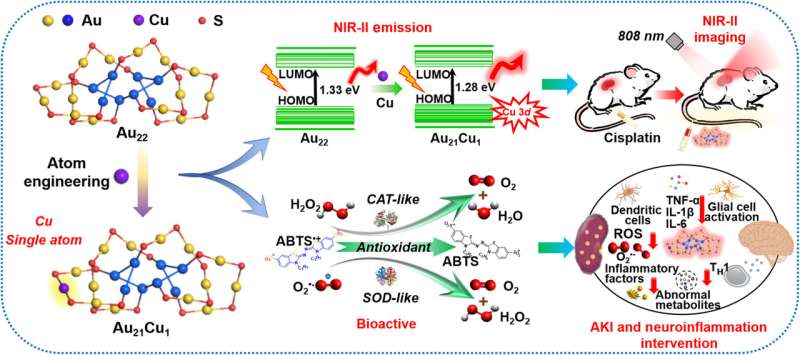
The bioactivity of most near-infrared II (NIRII) fluorophores are limited, thereby conflicting the achievement of strong fluorescence and high catalytic activities, due to a lack of free electrons in the method.
To overcome this challenge, Huizhen Ma and a research team in translational medicine, neural engineering, physics, and materials at the Tianjin University China developed atomically precise gold clusters with strong near-infrared II fluorescence to show potent enzyme-mimetic activities by using atomic engineering, to form active copper single-atom sites.
These gold-copper clusters (Au21Cu1) showed higher antioxidant nature with a 90-fold catalase-like and 3-fold higher superoxide dismutase-like activity compared to gold clusters alone. These clusters can be cleared through the kidney to monitor cisplatin-induced renal injury within a 20–120-minute window to visualize the process in 3D via near-infrared light-sheet microscopy.
The clusters prevented oxidative stress and inflammation in the kidney and the brain in a mouse model, which occurred as side-effects when treated with the anticancer drug cisplatin. The research is published in the journal Science Advances.
Monitoring the pathological evolution of oxidative-stress and inflammation in real-time
The method of near-infrared II (NIR-II) imaging offers high tissue penetration depth and signal-to-noise ratio to monitor the pathogenesis and pathological evolution of cancer with applications in neuroscience. The biocatalytic near-infrared II molecular agent is applicable to conduct real-time monitoring of pathological processes and molecular mechanisms of treatment.
Most oxidative stress-based diseases require early intervention to monitor pathological evolution in real-time. Biologists have conventionally relied on non-invasive imaging methods such as computed tomography and magnetic resonance imaging to achieve precise diagnostics and real-time analysis.
Oxidative stress and inflammation-related pathologies are however, common in clinics, necessitating real-time monitoring and intervention. Additionally, some chemotherapeutic agents often cause injury to normal tissues during medical treatment. For example, the anticancer drug cisplatin can crosslink DNA and induce oxidative stress and inflammation to result in neurotoxicity and nephrotoxicity.
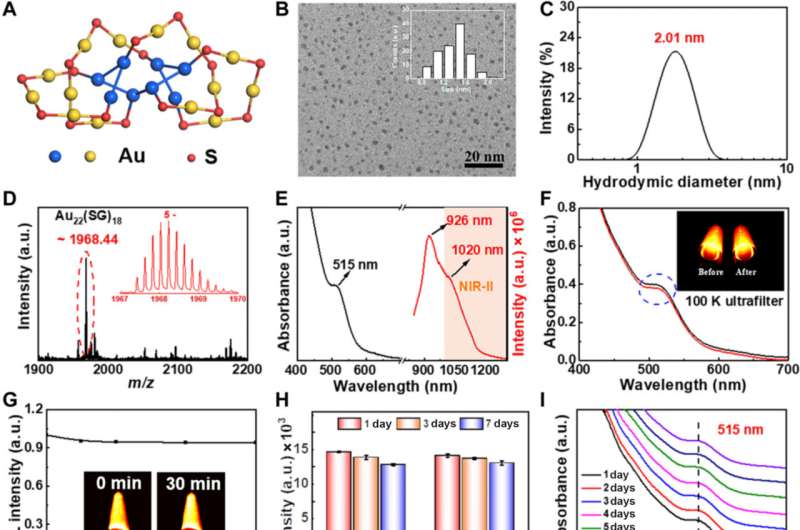
Cisplatin-induced acute kidney injury is a common side-effect that can cause a sudden decrease in kidney function within a few hours or days. Acute kidney injury must be monitored in real-time for early diagnosis and early intervention to prevent oxidative stress and acute inflammation.
It is desirable to engineer biocatalytic NIR-II molecular agents for real-time monitoring, to synchronously achieve the inhibition of oxidative stress and early inflammation. In this work, Ma et al. developed atomic precision gold clusters with NIR-II emersion and bioactive enzyme mimicry to inhibit oxidative stress and inflammation in the injured kidney and brain.
Doping gold clusters
The team prepared gold clusters (Au22) and purified them according to previous reports to create a stable structure, which they examined using transmission electron microscopy to reveal an ultrasmall size.
This allowed for efficient clearance during renal filtration. The gold clusters showed excellent photostability to reveal well-defined atomic precision engineering, water solubility, and a stable structure suited for further applications.
The team also included atomic engineering to modify gold clusters with various other metallic elements to obtain optical absorption spectra of the doped clusters. The outcomes highlighted gold-copper clusters to possess good homogeneity and dispersion, consistent with gold clusters alone.
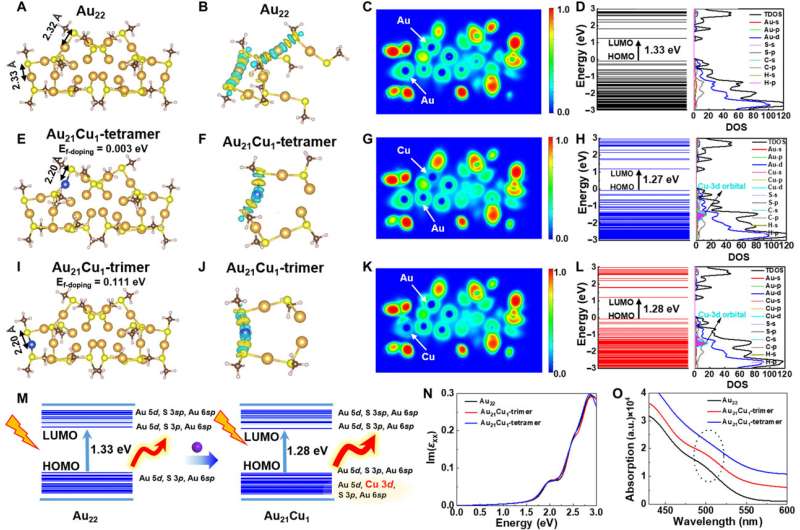
Enzymatic properties of gold clusters
The gold-copper clusters containing a single copper atom active site showed high catalytic activity. The researchers further assessed the reactive oxygen and nitrogen species absorption capacity on the molecules. The catalytic activity of the doped clusters were 90 times higher than of the pure gold alone.
This work also highlighted the impact of clusters with NIR-II properties in detail for the first time, as it plays a key role in the life sciences. The bioengineered bioactive NIR-II molecules also provided an urgent and significant platform to understand the mechanism. Ma et al. followed these experiments with density functional theory calculations of gold clusters.
Monitoring the kidney in real-time
The scientists next examined the impact of gold clusters for real-time kidney monitoring to examine kidney injury on mice in advance of clinical diagnosis. To accomplish this, they administered the anticancer drug cisplatin to mice via injection, the outcomes highlighted severe impairment of kidney function and influence on the nervous system upon cisplatin injection, where the filtering effect of the glomeruli weakened to accumulate gold clusters in the kidney.
The team conducted cytotoxicity tests to pinpoint the region of enzymatic biological activity of the clusters by monitoring proximal tubular cells and mouse microglia. The outcomes showed the capacity of the clusters to regulate oxidative stress and induce favorable biological activities without toxicity at high concentrations.
-
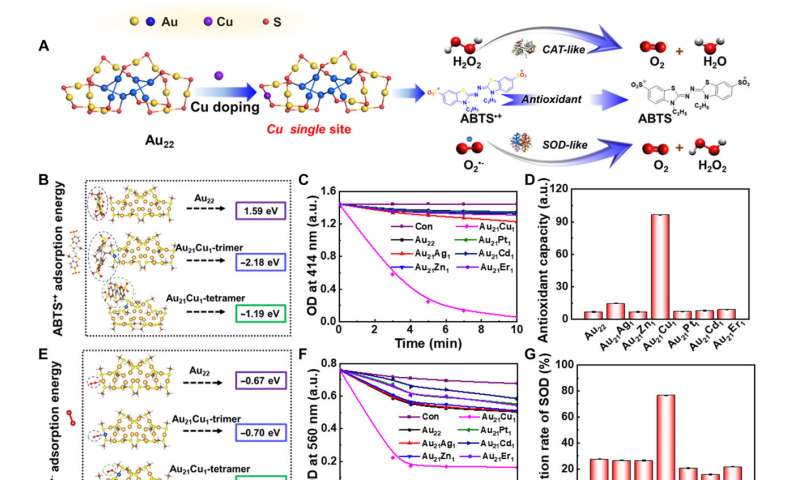
The enzyme-mimicking activity of gold clusters. (A) Schematic illustration of the enzyme-mimicking activity of Au22 clusters. (B) The adsorption energy of ABTS•+ on Au22, Au21Cu1-trimer, and Au21Cu1-tetramer clusters, respectively. Time-dependent curves (C) and quantitative results (D) of ABTS•+ of Au22 and Au21M1 (M: Ag, Zn, Cu, Pt, Cd, and Er) clusters. (E) The adsorption energy of O2•− on Au22, Au21Cu1-trimer, and Au21Cu1-tetramer clusters, respectively. Time-dependent curves (F) and quantitative results (G) of O2•− of Au22 and Au21M1 clusters. (H) The adsorption energy of H2O2 on Au22, Au21Cu1-trimer, and Au21Cu1-tetramer clusters, respectively. Diagram (I) and quantitative results (J) of the CAT-like activity of Au22 and Au21M1 clusters. (K) The adsorption energy of ONOO− on Au22, Au21Cu1-trimer, and Au21Cu1-tetramer clusters, respectively. Time-dependent curves (L) and quantitative results (M) of ONOO− of Au22 and Au21M1 clusters. Credit: Science Advances, doi: 10.1126/sciadv.adh7828 -
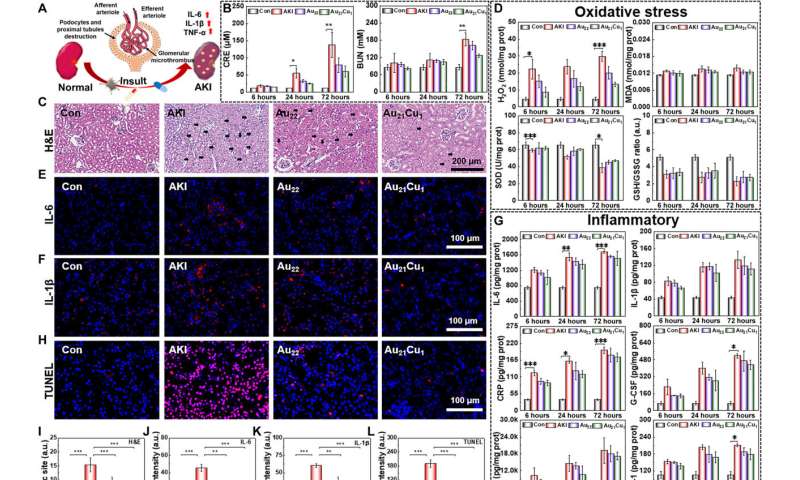
In vitro treatment of cisplatin-induced AKI with gold clusters. (A) Schematic diagram of cellular level experiments. HK2 cell viability in the presence of cisplatin with or without treatment of Au22 clusters (B) and Au21Cu1 (C) determined by CCK8 assays (n = 3 per group). BV2 cell viability in the presence of cisplatin with or without treatment of Au22 clusters (D) and Au21Cu1 (E) determined by CCK8 assays (n = 3 per group). (F) Fluorescence microscopic images of intracellular ROS and O2•− levels induced by cisplatin with or without gold clusters. Quantitative analysis of ROS (G) and O2•− (H) fluorescence intensity (n = 3 per group). (I to K) Fluorescence quantification of HK2 cells staining for ROS and O2•− by flow cytometry (n = 3 per group). (L to N) Fluorescence-activated cell sorting (FACS) results and fluorescence quantification of BV2 cells staining for ROS and O2•− by flow cytometry (n = 3 per group). The level of TNF-α in the cellular supernatant of HK2 cells (O) and BV2 cells (P) (n = 2 per group). (Q) Representative fluorescence image of TLR4 in HK2 cells. (R) Quantitative analysis of TLR4 fluorescence intensity. Data are presented as means ± SD; *P < 0.05, **P < 0.01, and ***P < 0.001 compared with the control group and cis group, analyzed by one-way analysis of variance (ANOVA) with the Tukey test. Credit: Science Advances, doi: 10.1126/sciadv.adh7828
Ma and colleagues studied the regulation of oxidative stress and inflammation induced by cisplatin. While cisplatin is an anticancer drug, it is limited by strong side-effects relative to nephrotoxicity and ischemic injury. The association with severe reactive oxygen species and inflammation leads to mortality and comorbidities in the brain.
This can be diagnosed in advance by monitoring serum creatinine and blood urea nitrogen; clinical manifestations of nitrogenous waste buildup that provide effective indices of kidney excretory function.
Outlook
In this way, Huizhen Ma and colleagues detailed atomic engineering of gold-copper clusters where a single copper atom allowed ultrahigh enzymatic mimicry. The antioxidant activity of the gold clusters were increased by introducing copper and the biological experiments showed capacity to inhibit both oxidation stress and inflammation in the kidney-brain axis during kidney disease.
The clusters also underwent effective renal clearance and revealed non-toxicity at a high dose, to provide a compound with efficient biosafety and multifunctionality, coupled with near-infrared II fluorescence. The gold clusters showed great potential for real-time imaging and early intervention during acute kidney injury with promising impact from the lab to clinical translation.
More information: Huizhen Ma et al, Bioactive NIR-II gold clusters for three-dimensional imaging and acute inflammation inhibition, Science Advances (2023). DOI: 10.1126/sciadv.adh7828
Peng Pei et al, X-ray-activated persistent luminescence nanomaterials for NIR-II imaging, Nature Nanotechnology (2021). DOI: 10.1038/s41565-021-00922-3
Journal information: Nature Nanotechnology , Science Advances
© 2023 Science X Network





















